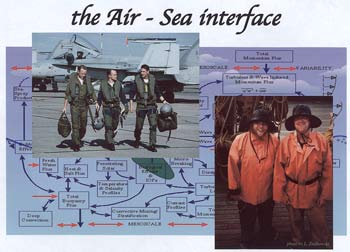By Cathy Carlyle
Bill Miller with an optical profiler for measuring the spectral distribution of light in the surface ocean as a function of depth
"Where we are right now, with the study of the air-sea interface and the exchanges and feedback between those two systems, is a very exciting place. The international community has recognized the interface as important...."
- Bill Miller
In presenting the 11th annual Harold I. Schiff Lecture at York in December, Bill Miller reflected on the complex relationship between the earth's lower atmosphere and the ocean, and confessed he and the scientific community have more questions than they can answer.
"Right now we don't know all the processes and we cannot model all the physical and chemical changes that happen between the air and the sea," said Miller, professor of chemical oceanography in the Department of Oceanography at Dalhousie University, Halifax.
Why study the air-sea interface? He explained: it covers about three-quarters of the planet, and is one of the most important systems for understanding feedback between climate change on time scales relevant to human activity. Ocean-atmosphere interactions have been studied in the past, but seldom simultaneously by oceanographers and atmospheric scientists.
"What happens if there is a change in solar radiation or in cloud cover. What effect does that have on the oceans? What about the deposition of iron in the ocean? How does everything link with biology?"
A new Canadian initiative has been launched to find some answers - the $8.9 million, five-year Surface Ocean Lower Atmosphere Study (SOLAS) funded by the Canadian Foundation for Climate and Atmospheric Science and the Natural Sciences Engineering and Research Council of Canada. Scientists will be studying the exchange between the ocean atmosphere and how it affects climate - and how it is affected by climate, hoping to amass quantitative data about the air-sea relationship.

The cloud-DMS-iron connection
The researchers will be measuring the dynamics of DMS (dimethylsulfide) and cloud formation. DMS is a sulfur gas which originates in microscopic marine plants. While DMS is partly broken down in the ocean, some is oxidized in the atmosphere and can cause clouds to form in pristine oceanic environments. "And clouds play an important role in reflecting some of the light from the sun back to space," explained Miller. "We don't currently know enough about ocean-atmopshere DMS exchange."
Scientists believe that if more clouds are formed, this increases reflection of solar radiation to space, resulting in less heat making it through the atmosphere. This has an impact on the surface temperature of the Earth.
"Consequently, if temperatures and light change, you change the biology (i.e. marine life) rates change; if marine life is altered, DMS production could change. One change affects the other and vice versa," said Miller.
The iron story...
"Iron is an element essential to all organisms, including the plants in the ocean," he said. "It is being deposited to the sea surface largely from dust storms that are swept to the upper atmosphere and conditioned by photochemical processes.
"By the time iron reaches its destination it is a highly-complex, highly-irradiated acidic aerosol mixture," said Miller. "It enters the ocean in these aerosol particles and oxidizes into a form that is available to microscopic plants or can be complexed with organic molecules. Photochemistry and organic complexation prevent iron from rapidly settling out of the sunlit surface ocean as particles, which would limit plant growth due to a lack of iron."
"Is this environmentally relevant?"
"Is this environmentally relevant?" asked Miller. "Yes. If you have an increase of iron in the surface ocean due to climate change, there could be a shift in plant and animal life - a change in the community structure. And we believe these ecological shifts could affect marine cloud formation through changes in the production and concentration of DMS. Any changes in the chemistry of the atmosphere could, in turn, alter the amount of iron available for plant growth in the sunlit surface ocean."
Added to the DMS-iron mix is global temperature. If the world's average temperature continues to increase, said Miller, chemical and biological reaction rates would speed up. Thus, the cycling of iron would be faster and perhaps effect marine community structure. Also, DMS, which is not as soluble in warm water, would be transferred more readily to the atmosphere.
"This means that the DMS flux could increase dramatically. If you add to that a change in wind speed, that, too, would change the rate of gas flux between the ocean and atmosphere. A windier atmosphere might also mean a higher iron deposition to the ocean.
Also, he added, the SOLAS scientists must gather data to aid in models of what would happen if the climate became wetter, dryer or less windy. "I haven't even discussed those scenarios today, yet all of those things could affect future climates scenarios. Consideration of all of this is the challenge I pose to you.